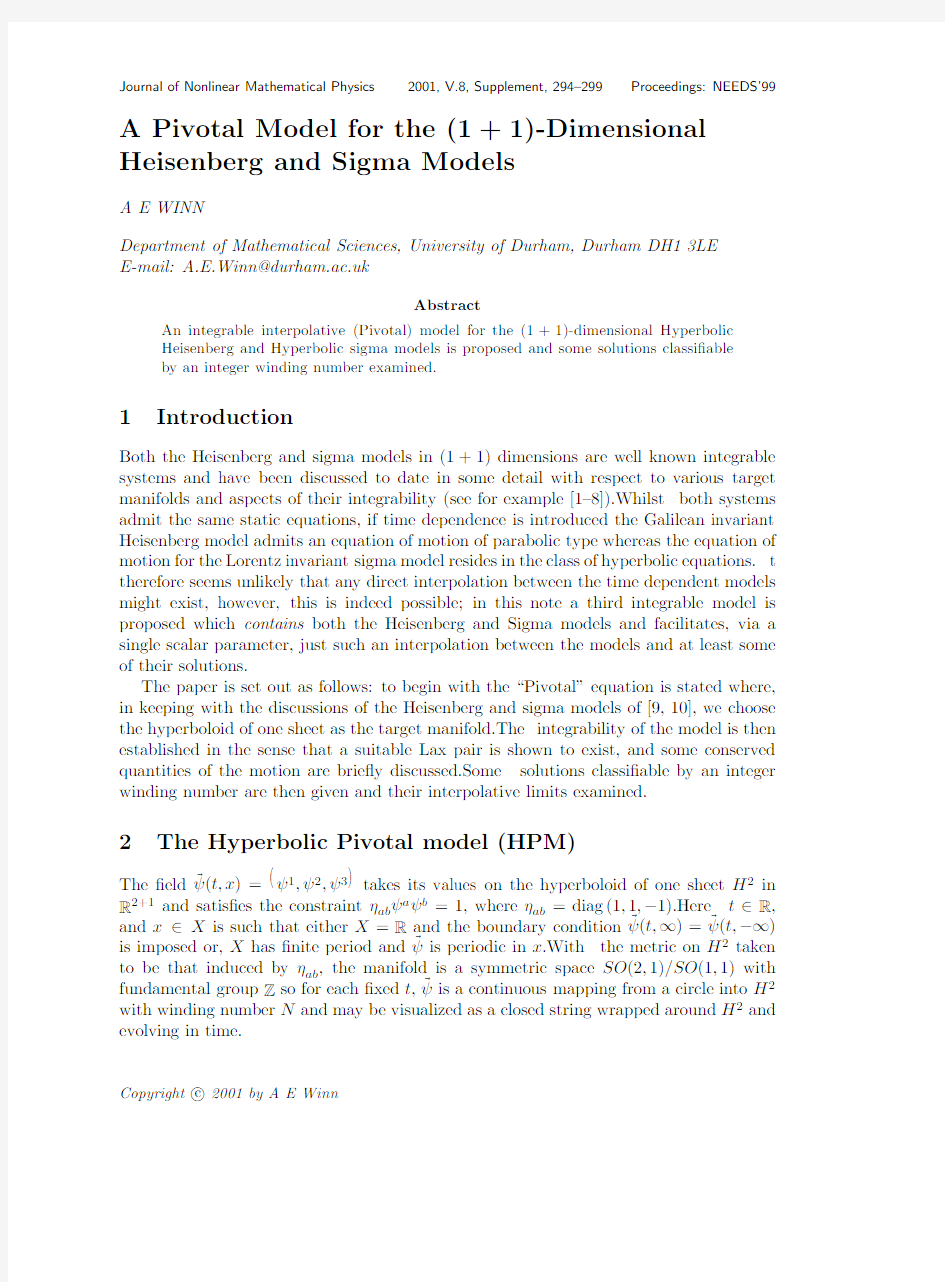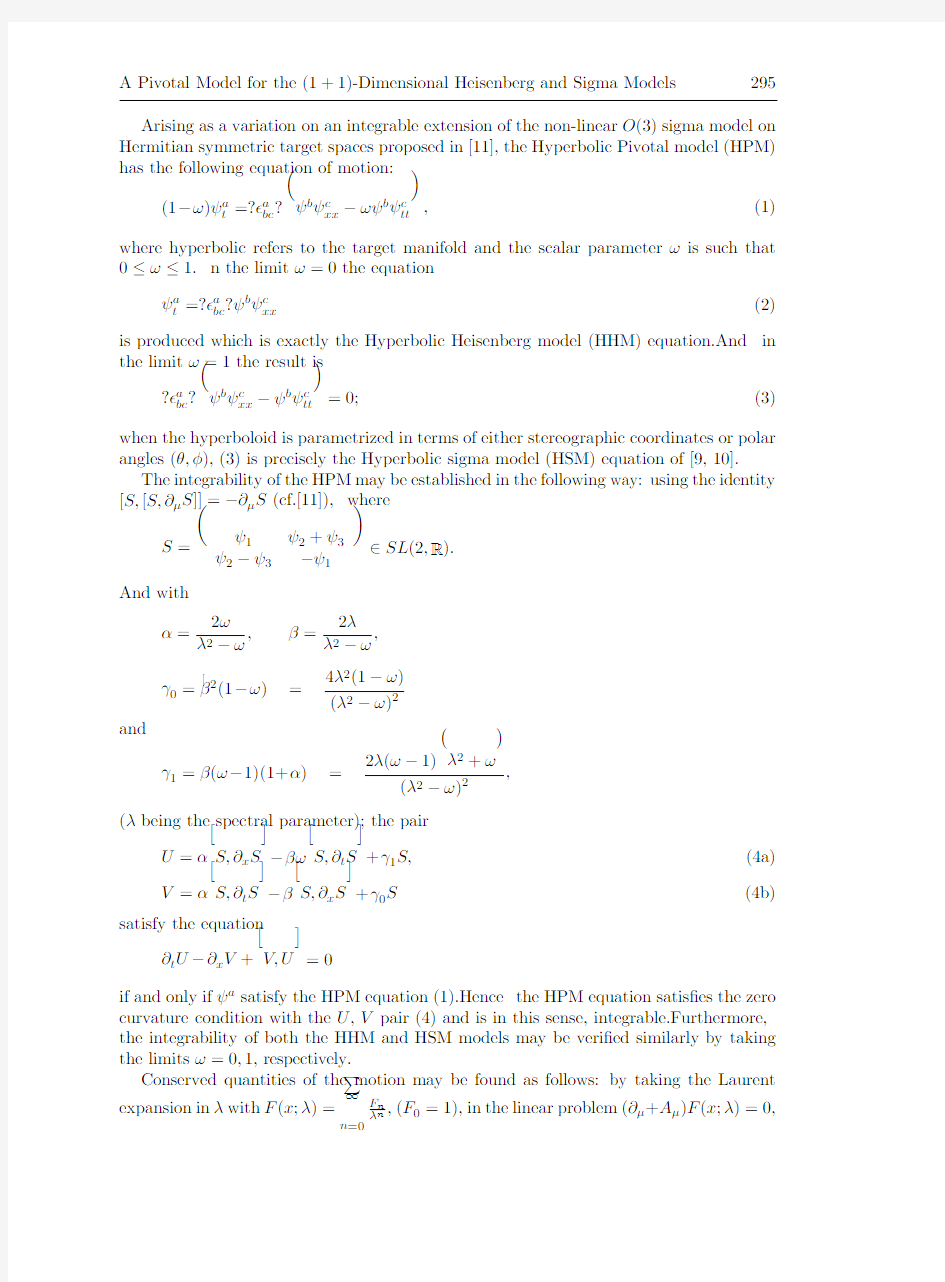A Pivotal Model for the (1 + 1)-Dimensional Heisenberg and Sigma Models


Journal of Nonlinear Mathematical Physics2001,V.8,Supplement,294–299Proceedings:NEEDS’99 A Pivotal Model for the(1+1)-Dimensional Heisenberg and Sigma Models
A E WINN
Department of Mathematical Sciences,University of Durham,Durham DH13LE
E-mail:A.E.Winn@https://www.360docs.net/doc/384835954.html,
Abstract
An integrable interpolative(Pivotal)model for the(1+1)-dimensional Hyperbolic
Heisenberg and Hyperbolic sigma models is proposed and some solutions classi?able
by an integer winding number examined.
1Introduction
Both the Heisenberg and sigma models in(1+1)dimensions are well known integrable systems and have been discussed to date in some detail with respect to various target manifolds and aspects of their integrability(see for example[1–8]).Whilst both systems admit the same static equations,if time dependence is introduced the Galilean invariant Heisenberg model admits an equation of motion of parabolic type whereas the equation of motion for the Lorentz invariant sigma model resides in the class of hyperbolic equations.t therefore seems unlikely that any direct interpolation between the time dependent models might exist,however,this is indeed possible;in this note a third integrable model is proposed which contains both the Heisenberg and Sigma models and facilitates,via a single scalar parameter,just such an interpolation between the models and at least some of their solutions.
The paper is set out as follows:to begin with the“Pivotal”equation is stated where, in keeping with the discussions of the Heisenberg and sigma models of[9,10],we choose the hyperboloid of one sheet as the target manifold.The integrability of the model is then established in the sense that a suitable Lax pair is shown to exist,and some conserved quantities of the motion are brie?y discussed.Some solutions classi?able by an integer winding number are then given and their interpolative limits examined.
2The Hyperbolic Pivotal model(HPM)
The?eld ψ(t,x)=
ψ1,ψ2,ψ3
takes its values on the hyperboloid of one sheet H2in
R2+1and satis?es the constraintηabψaψb=1,whereηab=diag(1,1,?1).Here t∈R, and x∈X is such that either X=R and the boundary condition ψ(t,∞)= ψ(t,?∞) is imposed or,X has?nite period and ψis periodic in x.With the metric on H2taken to be that induced byηab,the manifold is a symmetric space SO(2,1)/SO(1,1)with fundamental group Z so for each?xed t, ψis a continuous mapping from a circle into H2 with winding number N and may be visualized as a closed string wrapped around H2and evolving in time.
Copyright c 2001by A E Winn
A Pivotal Model for the (1+1)-Dimensional Heisenberg and Sigma Models 295Arising as a variation on an integrable extension of the non-linear O (3)sigma model on Hermitian symmetric target spaces proposed in [11],the Hyperbolic Pivotal model (HPM)has the following equation of motion:
(1?ω)ψa t =? a bc ? ψb ψc xx ?ωψb ψc tt ,(1)
where hyperbolic refers to the target manifold and the scalar parameter ωis such that 0≤ω≤1.I n the limit ω=0the equation
ψa t =? a bc ?ψb ψc xx (2)is produced which is exactly the Hyperbolic Heisenberg model (HHM)equation.And in the limit ω=1the result is ? a bc ? ψb ψc xx ?ψb ψc tt =0;
(3)when the hyperboloid is parametrized in terms of either stereographic coordinates or polar angles (θ,φ),(3)is precisely the Hyperbolic sigma model (HSM)equation of [9,10].
The integrability of the HPM may be established in the following way:using the identity
[S,[S,?μS ]]=??μS (cf.[11]),where
S = ψ1ψ2+ψ3ψ2?ψ3?ψ1
∈SL (2,R ).And with
α=2ωλ2?ω,β=
2λλ2?ω,γ0=β2(1?ω)=4λ2(1?ω)
(λ2?ω)2
and γ1=β(ω?1)(1+α)=2λ(ω?1) λ2+ω (λ2?ω)2,
(λbeing the spectral parameter);the pair
U =α S,?x S ?βω S,?t S +γ1S,
(4a)V =α S,?t S ?β S,?x S +γ0S
(4b)
satisfy the equation
?t U ??x V + V,U =0if and only if ψa satisfy the HPM equation (1).Hence the HPM equation satis?es the zero curvature condition with the U ,V pair (4)and is in this sense,integrable.Furthermore,the integrability of both the HHM and HSM models may be veri?ed similarly by taking the limits ω=0,1,respectively.
Conserved quantities of the motion may be found as follows:by taking the Laurent expansion in λwith F (x ;λ)=∞ n =0
F n λn ,(F 0=1),in the linear problem (?μ+A μ)F (x ;λ)=0,
296A E Winn (Aμ~U,V),and de?ning the conserved current as J(n)μ= μν?νF n(x),which satisfy the current conservation?μJμ=0;to?rst order one has
(?0??1)F1?2
[S,?1S]?ω[S,?0S]?(1?ω)S
=0.
The current conservation here is just the equation of motion(1)and is in fact,a local conservation law since(1)is a vector divergence equation.To second order one has
0=(?0??1)F2+2ω
[S,?0S]?[S,?1S]
+4(1?ω)S
?2F1
[S,?1S]?ω[S,?0S]?(1?ω)S
(5)
which is non-local as are the higher order currents which may be similarly obtained ad in?nitum.
3Topological solitons
Since our main concern for the HHM and HSM in[9,10]was the existence of topological solitons,let us expand this investigation to the Pivotal model case;this may also give some insight into how the interpolation holds up under scrutiny with respect to solutions of the model.
3.1Travelling waves
The hyperboloid H2may be parametrized in terms of the polar angles(θ,φ)whereθ∈(?∞,∞),φ∈[0,2π]such that
ψ=(coshθcosφ,coshθsinφ,sinhθ).
Further,using the characteristic variableξ=x?vt so thatθ(t,x)andφ(t,x)are replaced by f(ξ)and g(ξ)respectively;in(1)and with the substitution p=sinh f one?nds the following equations for p and g:
2
1?ωv2
2
p 2=4qp2?v(1?ω)kp+4q?2
(1?ω)2v2?k2
(6)
and
1?ωv2
g =
vp(ω?1)+k
1+p2
,(7)
where“prime”denotes di?erentiation with respect toξand q and k are constants.On integration,(6)yields the solution
p(ξ)=sinh f=
A
sin
√
B(ξ?ξ0)
(1?ωv2)
+p0,(8)
where the constants A=2q?v2(1?ω)2+k2?2k2v2(1?ω)
q
,B=?2q are both positive
and p0=kv(1?ω)
2q .This solution is of topological type with X=S1,which may be
checked by substituting(8)into(7)and integrating with respect to x.Analyzing the result(cf.similar result in[10])one?nds that the solution does indeed wind around the
A Pivotal Model for the (1+1)-Dimensional Heisenberg and Sigma Models 297hyperboloid an integer number of times.Furthermore,in the limits of the parameter ωthe solution reduces to one for both the HHM and HSM models where in the sigma model case the resultant solution is related to a Lorentz boost of the static case 1.Hence the above is a topological soliton of travelling wave type for X =S 1and is a solution of all three models which can be seen by varying the parameter ω.
Investigation into the existence of travelling waves where X is the real line is omitted due to space considerations and will be covered in a subsequent paper,however,in the next section it will be shown that time dependent solutions not of travelling wave type are possible for X =R .
3.2Solutions from a stereographic parametrization of H 2
If the hyperboloid is parametrized in terms of a stereographic projection such that ψ=ζ?1 1?u 2+v 2,2u,2v ,where ζ=1+u 2?v 2;in the relevant limits of ωthe HPM
equations reduce to both the HHM and HSM equations.Letting u 2?v 2=f (x )2and choosing
u (t,x )=f (x )cosh(mt ),
(9a)v (t,x )=f (x )sinh(mt )(9b)with m constant;substitution of (9)into the parametrized system produces a second order equation for f which,on integration (cf.[12])results in the ?rst order equation
f 2=14 m 2ω2?k 1+f 2 2+m (1?ω)2 f 2+1 f 2?1 ?m 2ω4
f 2?1 2.(10)This is satis?ed by the elliptic solution
f (x )=A sc [B (x ?x 0)|M ],
(11)where B 2=18 2l +3m 2ω±2m 2[2ωl +m 2ω2+2(1?ω)2] ,(12a)A 2=3m 2ω+2l ?2m 2[2ωl +m 2ω2+2(1?ω)2]2l ?m 2ω+4m (1?w ),(12b)M =±4m 2[2ωl +m 2ω2+2(1?ω)2]2l +3m 2ω±2m 2ω22,(12c)l =?k >0,M is the elliptic function parameter and the signs are ordered throughout.Taking m >0and the positive square root in B 2,one then has both M and B 2≥0and the only constraints arise from A 2≥0and the fact that,with respect to the elliptic function,things are simpli?ed if 0≤M ≤1.Both stipulations result in the single constraint
2l ?m 2ω≥4m (1?ω).
(13)Taking the limit of the parameter M =0,one then has A =±1and B =±√l 2so that if
l =4,the static solution f (x )=tan x is recovered (and is a solution for all three models).
1
Note that all static solutions of the HPM are also solutions for the other two models and vice versa since the static equations are the same for all three models.
298
A E Winn If x is now shifted by the half period K :x ?→K ?x then
A sc [K ?x |M ]=μcs [Bx |M ]
(14)(where μ=A √1?M )and the solution f (x )=μcs (Bx |M )
(15)is well de?ned with the parameters (12)and the constraint (13).Further,with (15)and u,v as in (9), ψis a topological (t dependent)soliton with period 2K .Taking the limit M =1requires 2l ?m 2ω=±4m (1?ω)and choosing the positive case results in μ= mω(1?ω),B = m 2ω+m (1?ω)and the solution
f (x )=±
mω(1?ω)+1 12cosech m 2ω+m (1?ω)(x ?x 0) .(16)
This passes through the points ψ
=(±1,0,0)if X =R and hence winds once around the hyperboloid,so that (16)is a topological t dependent soliton where X is the real line.It remains now to examine how (15)behaves in the limiting models which we consider separately as follows:
(i)If ω=0(i.e.for HHM),one has B =±√l +2m 2,A =
2l ?4m 2l +4m ,M =8m 2l +4m and μ=√M .Hence,if l ≥2m ,(15)has a satisfactory reduction to a topological
soliton in terms of elliptic functions for the Heisenberg model.Taking the limit M =1requires l =2m and the corresponding solution (putting m =1for example),is given by f (x )=cosech x which again winds once around the hyperboloid for X =R .(ii)In the w =1(i.e.HSM)limit the situation is not quite so straightforward;here one
has
B 2=18 2l +3m 2+2m 2(2l +m 2) ,A 2=3m 2+2l ?2m 22l ?m 2
,M =4m 22l +3m 2+2m 2(2l +m 2)resulting in μ=
4m [2(2l +m 2)]12
2l ?m 2.I
f 2l >m 2the solution (15)is perfectly valid for
the sigma model and is topological in its elliptic form (and of course,in the static (M =m =0)case).However,taking the limit M =1requires 2l =m 2so that f (x )diverges.Nevertheless,it is interesting to note that as M gets close to unity the solution does actually come close to a “cosech”.For example,taking l =2.1and m =2one has M ≈0.999962and μ≈161.99(with B ≈4)so that such a solution is approximated as the limit is approached.
A Pivotal Model for the(1+1)-Dimensional Heisenberg and Sigma Models299 4Concluding remarks
There are few known parabolic or hyperbolic systems which are both integrable and ad-mit topological solitons;the Heisenberg and sigma models are of this type.The Pivotal system proposed here is also of this type and moreover,contains a parabolic system(the HHM)which is Galilean invariant,and a Lorentz invariant hyperbolic system(the HSM). Furthermore,as documented,at least some of the solutions and properties of this Pivotal model“carry through”to the two constituent models via the scalar parameterω.With these combined properties it is therefore believed that the Pivotal model is unique among known systems.Since the model is new,there are obviously many possibilities for further investigation,for example,its complete integrability via the inverse scattering transform, the symmetries of the model and its applications,however,these must be left for the future.
Acknowledgements
The author would like to thank Professor R S Ward for his help and support over the past four years,and the organizers and participants of NEEDS’97,’98and’99for both academic and social enlightenment.
References
[1]Zakharov V E and Takhtajan L,Teor.Mat.Fiz.,1979,V.38,27.
[2]Faddeev L D and Takhtajan L A,Hamiltonian Methods in the Theory of Solitons,Springer
Verlag,Berlin,1987.
[3]Kundu A,Lett.Math.Phys.,1982,V.6,479;J.Phys.A:Math.Gen.,1986,V.19,1303.
[4]Pashaev O K and Lee J-H,Resonance NLS Solitons as Black Holes in Madelung Fluid,1998.
[5]Zakharov V E and Mikhailov A V,Sov.Phys.JETP,1978,V.47,V.6,1017.
[6]Pohlmeyer K,Comm.Math.Phys.,1976,V.46,207.
[7]Eichenherr H and Honerkamp J,J.Math.Phys.,1981,V.22,N2,374.
[8]de Vega H J and Sanchez N,Phys.Rev.D.,1993,V.47,N8,3394.
[9]Ward R S and Winn A E,J.Phys.A:Math.Gen.,1998,V.31,L261.
[10]Winn A E,Preprint:math.AP/9811135,in Proc.NEEDS’98(to be published)
[11]Oh P,J.Phys.A:Math.Gen.,1998,V.31,L325.
[12]nce E L,Ordinary Di?erential Equations,Green and Co.Ltd.,Longmans,1927.
